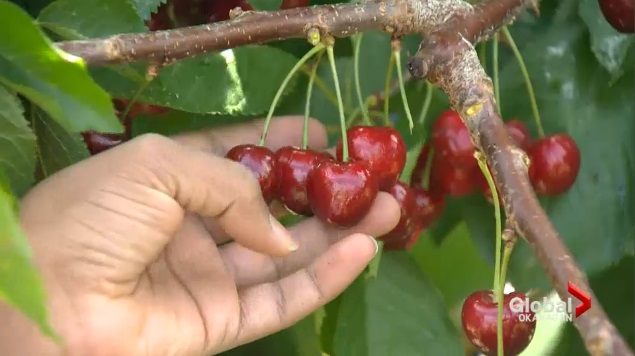Residents in the South Okanagan can now get their hands on this year’s first crop of cherries, and the rest of the valley isn’t far behind.

Paramjit Rai with Rai Produce in Osoyoos, B.C., says his company is selling sweet and ripe Chelan cherries at its family-run fruit stand just west of Osoyoos on Highway 3.
“They look good — good size, good colour,” he said.
Rai said about 10 per cent of his cherry crops are exported to China, and he is optimistic it will be a good year for cherry producers.
WATCH (July 3, 2018): Researchers in Summerland, B.C., are developing a device to assist cherry growers with improving quality assurance

“We’re expecting a good season. Hopefully, we get a good price because there are not so many cherries in the area,” he said.
Okanagan cherry growers may see lighter crops because of a cold winter, which can damage cherry buds.

Get daily National news
“The buds, some would have been damaged by the cold because we got below -20 C in some areas,” said Sukhpaul Bal, president of the B.C. Cherry Association.
“Some growers are saying they’ve got an OK-sized crop, some are saying some varieties are very light so, number-wise, I’m thinking more it’s going to be average or a touch below average-size crops,” Bal said.
The B.C. Tree Fruits Co-operative, which represents 400 grower families in the region, said the cool spring, combined with wind, also affected bee pollination.
Growers are expected to produce eight million pounds of cherries this season compared to 10 million pounds the previous two years.
“The cold snap that we had, a lot of it did come during the select and small window of pollination,” said B.C. Tree Fruits Co-operative marketing manager Chris Pollock.
While there may be fewer cherries this season, those that managed to grow are said to be larger and juicier.
“The remaining cherries on the tree get larger because they get more nutrients so that means the cherries should be slightly larger than in a full crop year,” said Glen Lucas, general manager of the B.C. Fruit Growers’ Association.
WATCH (June 30, 2017): Access to Chinese market a ‘game changer’ for Okanagan cherry producers

Lucas pointed out that he’s heard California is in short supply of cherries due to inclement weather so he says the industry is “expecting, for growers, strong pricing throughout the year.”
While early crops will be available for local consumption, most of the 2019 harvest will be destined for overseas markets — particularly in Asia, where producers can get the highest price.
“Once the Washington (state) volumes pick up then we see a lot of Washington fruit into the market and then that’s where we tend to look at the overseas markets to get a premium price,” he said.
Bal said it will also be the first season that Okanagan growers will have access to the Japanese market after the Canadian government reached a trade deal with Japan last August.
“That will be interesting to see how much volume goes there and what type of cherries,” he said.
According to a press release by Agriculture and Agri-food Canada, Japan imported C$62.7 million worth of fresh cherries from around the world in 2017. Industry experts predict fresh cherry exports to Japan could be worth up to $8 million annually.
“It’s good to now have another market in Asia to access. Vietnam has been taking quite a bit of cherries as well, and Taiwan,” Bal said.








Comments